"Protect Your Distinct Designs Before Someone Else Takes Credit For Them." With Design Registration
✅ Secure Your Industrial Design with 100% Ownership & 0% Hassle
At Corporate Verdict, we assist creators, entrepreneurs, and companies to lawfully protect the visual look of their products — so that you can concentrate on innovation, with us handling the legality.
What You Receive with Design Registration at Corporate Verdict:
✅ Design Application Filing within 2 Working Days
✅ Exhaustive Design Search & Eligibility Check by Legal Professionals
✅ Classification Guidance according to Locarno Classification (as per Indian Law)
✅ Detailed Representation Sheet Support (for product images/sketches)
✅ Examination Report & Reply Filing Handling (if necessary)
✅ Tracking & Updates During the Registration Process
✅ Free Consultation on Design Strategy & IPR Protection

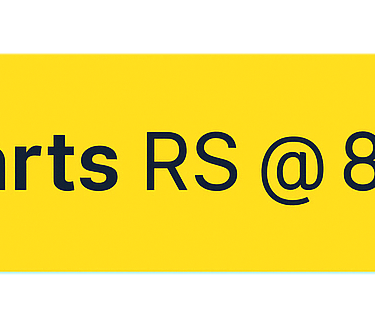
🛡️ Protect Your Design Legacy — Register Your Aesthetic Creation with Corporate Verdict Today!
🧩 What is Design Registration?
Design Registration is an Intellectual Property (IP) protection accorded to the novel exterior appearance of an article. Its shape, pattern, configuration, lines, or ornamentation, used on any article by any industrial process, either manual, mechanical, chemical, or combined, falls within it.
✅ Does not cover the technical or functional features — merely the appearance of the product.
📜Legal Basis: Designs Act, 2000
In India, Design Registration is administered by the Designs Act, 2000 and is overseen by the Controller General of Patents, Designs, and Trademarks (CGPDTM) under the Ministry of Commerce and Industry.
🎨What Is Registerable as a Design?
A design should satisfy the following criteria:
✅ It should be new or original
✅ It should not have been made available to the public in India or elsewhere prior to the date of application
✅ It should be clearly distinguishable from existing ones
✅ It should be used for an article through an industrial process
✅ The design should be non-functional (aesthetic only)
🚫What Cannot Be Registered?
❌ Design related only to the functional/technical aspects
❌ Immoral or obscene designs
❌ Designs contrary to public order
❌ Already published or in public domain
❌ Logos, names, or trademarks (they are protected by trademark law)
📅Term of Design Protection
First protected for 10 years. Renewable for 5 additional years (in all 15 years). Upon expiration, the design goes into the public domain
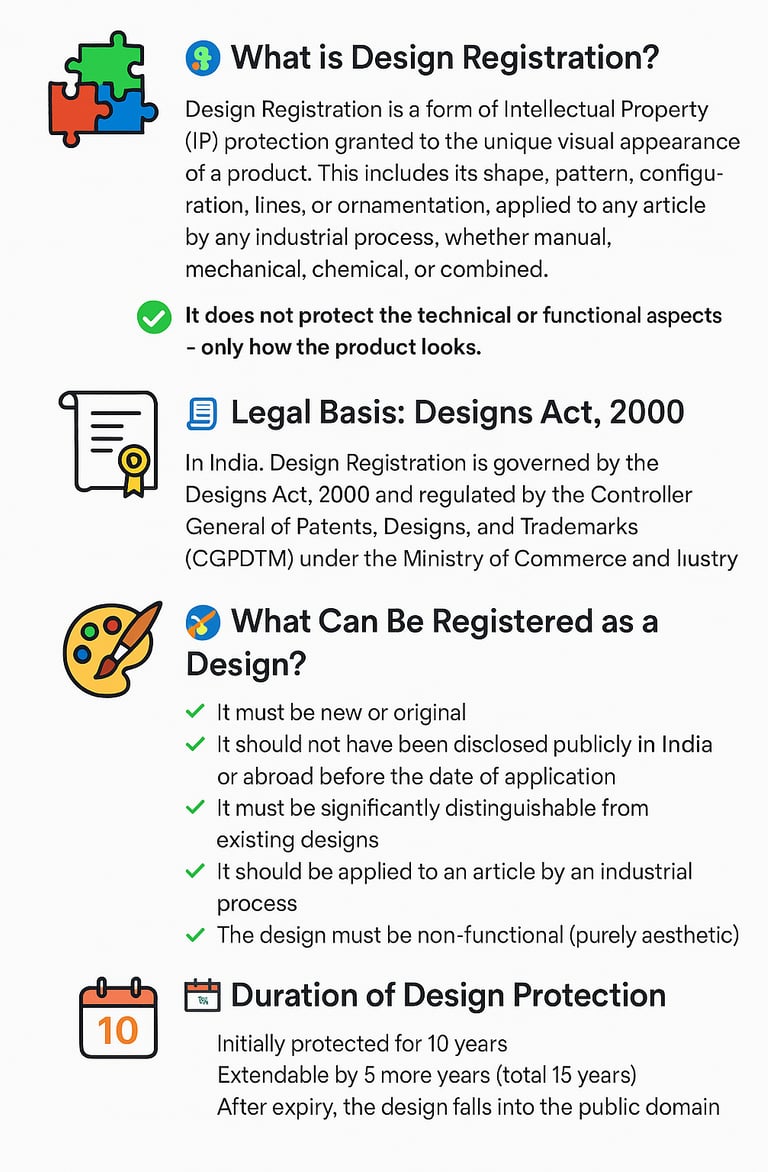

📋 Benefits of Register a Design in India
1️⃣ Sole Ownership Rights
Retain the legal right to prevent others from copying, producing, or selling products that reproduce your registered design.
2️⃣ Protection from Infringement under Law
If anyone replicates your design, you can pursue legal remedies for injunctions, damages, or account of profits under the Designs Act, 2000.
3️⃣ Creates Distinctive Identity in the Marketplace
A unique design makes your product more noticeable and desirable, distinguishing it from ordinary substitutes.
4️⃣ Commercial Asset
A registered design becomes a prized intellectual property asset, which can be:
* Sold (assigned)
* Licensed for royalties
* Transferred or inherited
5️⃣ Increases Business Valuation
Investors and customers view registered IP as a badge of innovation and credibility, enhancing your startup or business valuation.
6️⃣ Gains Consumer Trust & Loyalty
Visually unique products are more memorable and trustworthy — allowing you to foster long-term customer relationships.
7️⃣ Fosters Innovation
Being confident that the design will be legally protected encourages firms to develop more innovative and distinctive products.
8️⃣ International Filing Advantage
After being registered in India, the design can be filed in foreign countries under the Paris Convention or Hague Agreement, subject to priority rights.
9️⃣ Low-Cost, High-Return Protection
In contrast to litigation or trademark/patent registration, design registration is a cost-effective, easy IP protection tool.
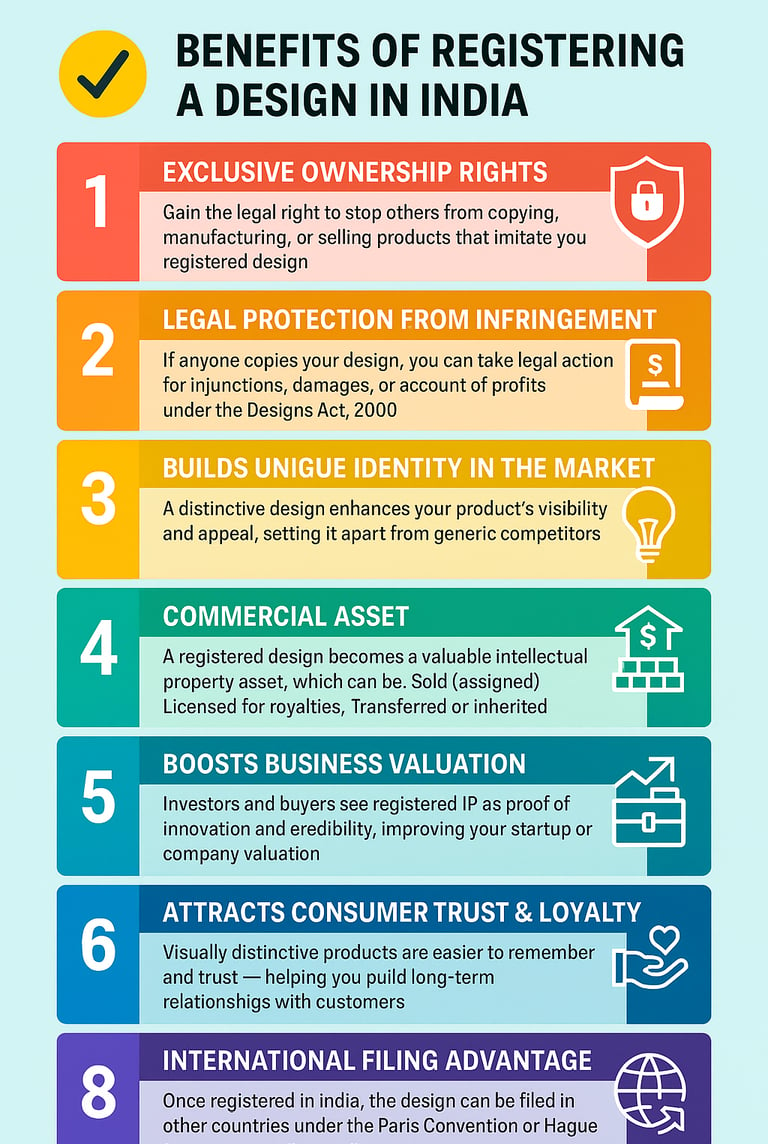

🧾 Eligibility Criteria for Design Registration in India
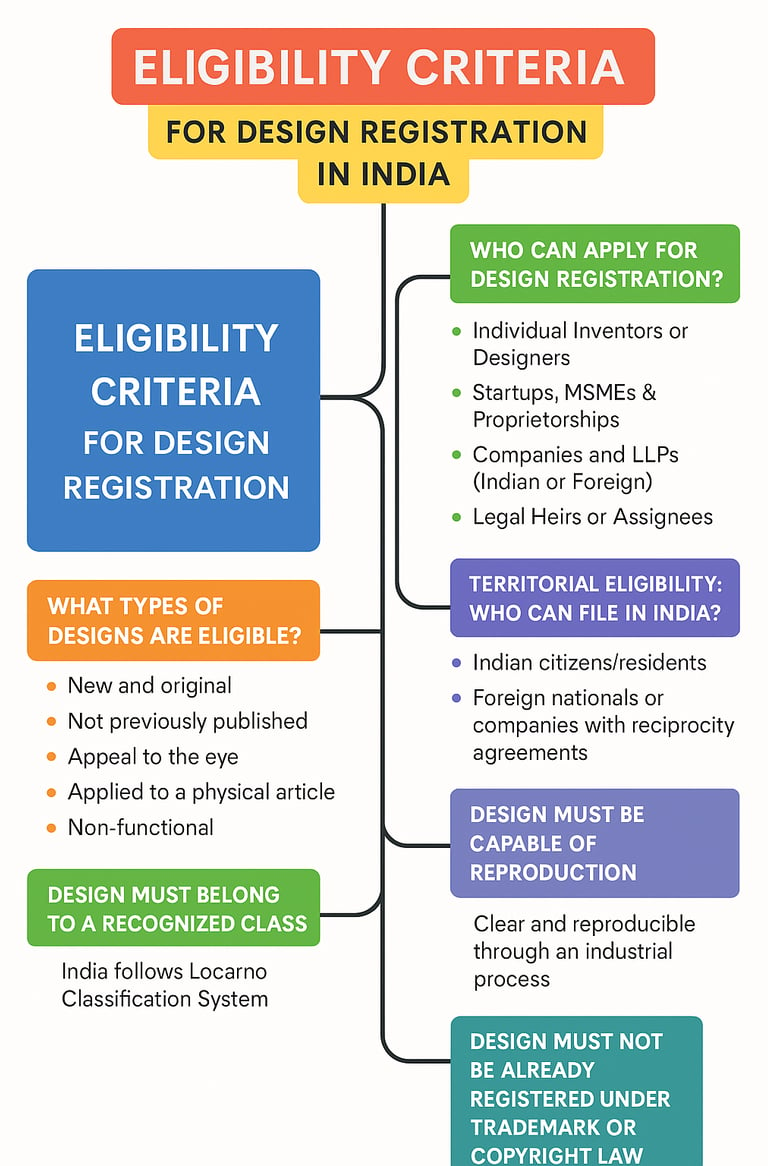

Eligibility Criteria for Design Registration in India
1️⃣ Who Can Apply for Design Registration?
The following are eligible to apply for the registration of a design pursuant to the Designs Act, 2000:
* Individual Inventors or Designers
Any individual who has developed a new and novel design.
* Startups, MSMEs & Proprietorships
Companies looking for protection for the appearance of their product.
* Companies and LLPs (Indian or Foreign)
Corporate firms which undertake or obtain designs as part of product development.
* Legal Heirs or Assignees
An individual who inherits or has been transferred the right to a design.
* Foreign Applicants
Foreigners or non-Indian entities are also eligible to apply, subject to their nation having a reciprocity agreement with India.
2️⃣ What Kind of Designs Qualify for Registration?
To be registerable, a design should satisfy all the below conditions:
✅ New and Original
The design must be completely novel, never previously disclosed in India or any other country prior to the date of filing.
✅ Not Previously Published or Used
A design that already exists or is known to the public domain — either by publication, use, or exhibition — is ineligible.
✅ Must Appeal to the Eye
Only designs that are eye appealing or can be judged solely by the eye are valid. The emphasis lies in looks, not function.
✅ Must Be Applied to an Article
The design should be used on a physical product or article, including:
* Consumer products (e.g., bottles, cutlery, pens) * Fashion products (e.g., jewellery, footwear) * Industrial goods (e.g., machine covers, packaging) Software, websites, or UI/UX designs are not covered under the Designs Act. ✅ Not Functional in Nature The protection is only for the esthetic aspects of a product. Any aspect determined only by its technical or functional nature is not registrable. ✅ Not Against Public Morality or Order Those designs that are immoral, obscene, scandalous, or offensive in nature will be rejected categorically.
3️⃣ Territorial Eligibility: Who Can File in India?
* Indian Citizens/Residents Anyone or organization based out of India is eligible to apply.
*Foreign Nationals or Companies Only permitted to apply if their country of origin provides reciprocal rights to Indian applicants.
4️⃣ Design Must Belong to a Recognized Class
India adheres to the Locarno Classification, where designs are classified into various classes and subclasses according to the article type.
Correct classification is compulsory for registration. For instance:
* Class 2: Articles of clothing * Class 6: Furnishing * Class 9: Packaging and containers * Class 23: Fluid distribution equipment, Incorrect classification can result in objection or delay in registration.
5️⃣ Design Must Be Capable of Reproduction
The design should be able to be represented clearly by drawings or images and should be reproducible by an industrial process such as molding, casting, engraving, printing, etc.
6️⃣ Design Should Not Be a Trademark, Work of Art, or Patent
You cannot register as a "design" if the creation: Is *already registered as a trademark** Is *covered under copyright law** (such as paintings or sculptures) Is *functionally protected** by a patent. Design law only guards external visual attributes, but not brand titles or works of art.
📚 Design Types Explained – Choose What’s Right for You
Design Types Explained – Choose What's Right for You
While registering a design in India, it is crucial to learn about the types of designs eligible for protection under the Designs Act, 2000. Every design type is categorized on the basis of its visual aspects and usage. Choosing the appropriate category makes sure it gets correct protection and does not lead to legal issues.
🧩1. Industrial Designs
These are aesthetic characteristics used for products that are produced in large numbers. They encompass the form, pattern, configuration, or ornamentation of any item.
Example: The distinctive shape of a water bottle or a chair.
✅ Most popular type of design registered under the Designs Act.
👜2. Product Packaging Designs
Designs that safeguard the visual arrangement of packaging, i.e., boxes, bottles, jars, and wrappers. Example: A specially shaped perfume bottle or an ornamental box of chocolates.
👞3. Fashion & Textile Designs
These include surface decoration and designs on clothing, fabrics, shoes, handbags, or jewelry.
Example: A floral print put on sarees or a special sandal design.
🛏️4. Home Décor & Furnishing Designs
Comprises ornamental designs of furniture, lampshades, vases, bed frames, etc., which are of aesthetic interest. Example: An ornately carved sofa or contemporary minimalist lamp design.
🧸5. Toys, Stationery & Consumer Goods
The outward design of toys, school sets, mobile cases, bottles, cutlery, etc. Example: Cartoon-style pencil box or curved shape of a spoon.
🚗6. Automotive & Mechanical Parts
Designs used on visible components of machines and cars — like grills, wheels, helmets, or casings. Example: Novel car headlight shape or motorcycle fuel tank silhouette.
🧴7. Medical Devices & Cosmetic Containers
Design of containers, devices, dispensers, syringes, etc. Example: S-curve hand sanitizer bottle or themed inhaler case.
📦Choosing the Right Type?
✔️ Function: Select based on how it will be utilized (utility + look).
✔️ Industry: Register under the industry category (e.g., textile vs. plasticware).
✔️ Visibility: Make sure the design is visible when it's in normal use — only then can it be protected.
✔️ Classification: Employ Locarno Classification to find the right class and subclass
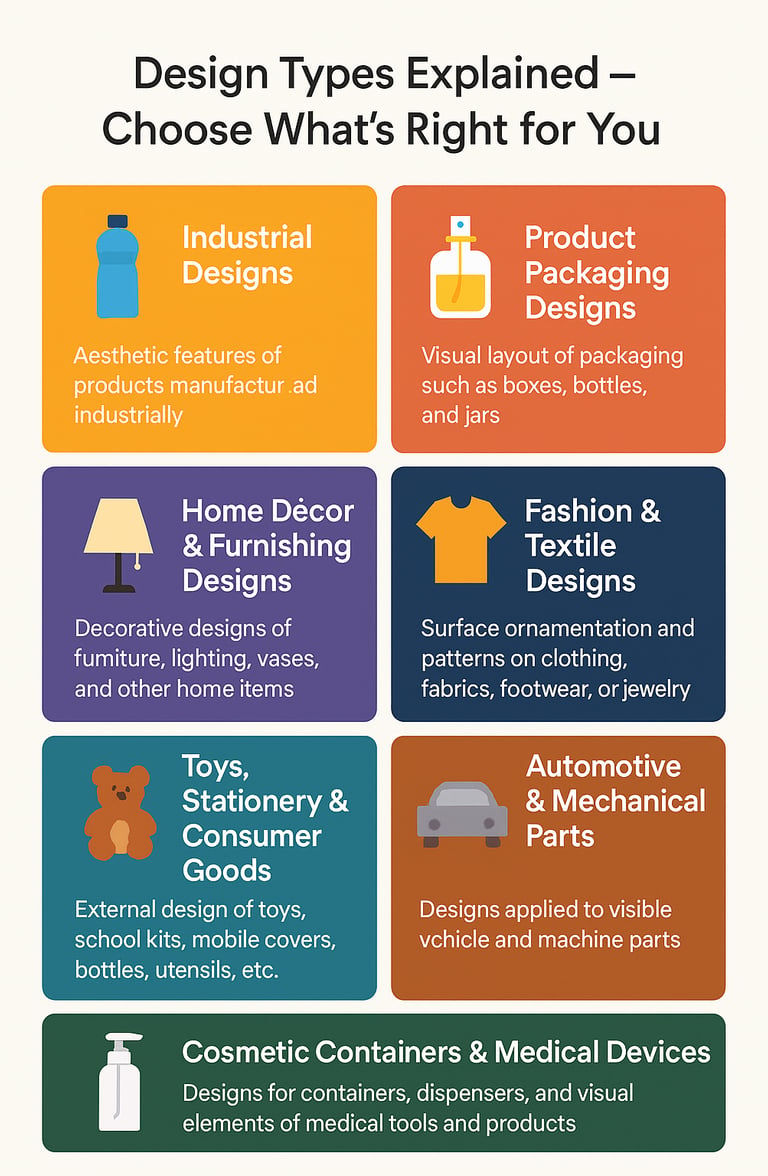

🔐 What You Need: Documents for Brand Name or Logo Registration
To register a design under the Designs Act, 2000, you need the following documents and information. Ensure all documents are accurate, complete, and well-formatted so that they are not rejected or delayed.
✅ 1. Form-1 (Application for Registration of Design)
This is the official application form as prescribed by the Indian Patent Office. It should have applicant information, class and article name, and priority claims (if any).
✅ 2. Representations of the Design (Drawings or Photographs)
* 7 copies of the representation of the design are needed.
Each copy should depict the *article from various views** — front, rear, top, bottom, left, and right, and perspective.
Should be *clear, readable, and A4 size** with no shadows or additional elements.
For 3D designs, *shading or broken lines** can be employed to indicate depth.
✅ 3. Statement of Novelty
A brief statement (not more than 100 words) outlining the novel and distinguishing characteristics of the design. This serves to establish its originality and distinguishability.
✅ 4. Power of Attorney (if filed through an agent)
If the application is being made by a patent/trademark/design agent or attorney on behalf of the applicant, a signed General Power of Attorney must be supplied.
✅ 5. Certified Copy of Priority Document (if applicable)
In case you are claiming foreign priority (Paris Convention), a certified copy of the original design application made overseas should be filed within 6 months.
✅ 6. Declaration of Ownership
A statement to the effect that the applicant is the original proprietor or true owner of the design.
✅ 7. Receipt of Fee Payment
Government fee applicable should be paid according to:
* Type of applicant (individual/startup/company)
* Number of designs/class
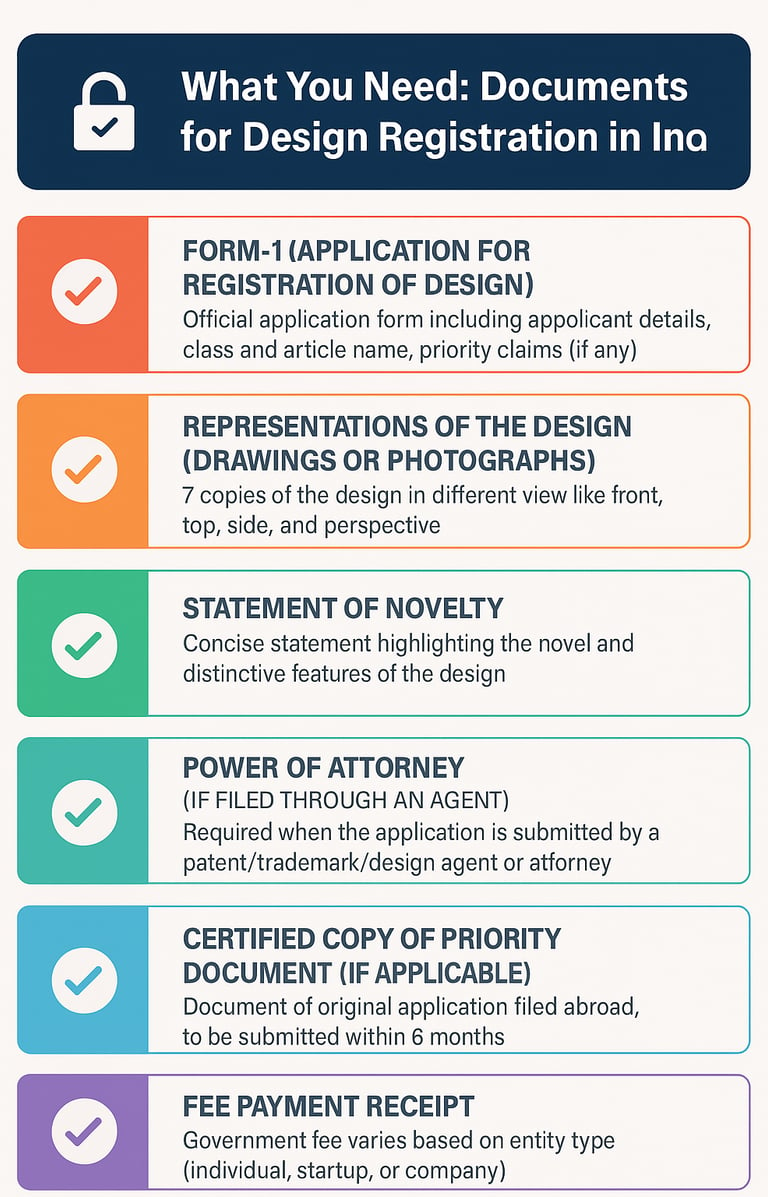

🏢Step-by-Step Design Registration Process in India
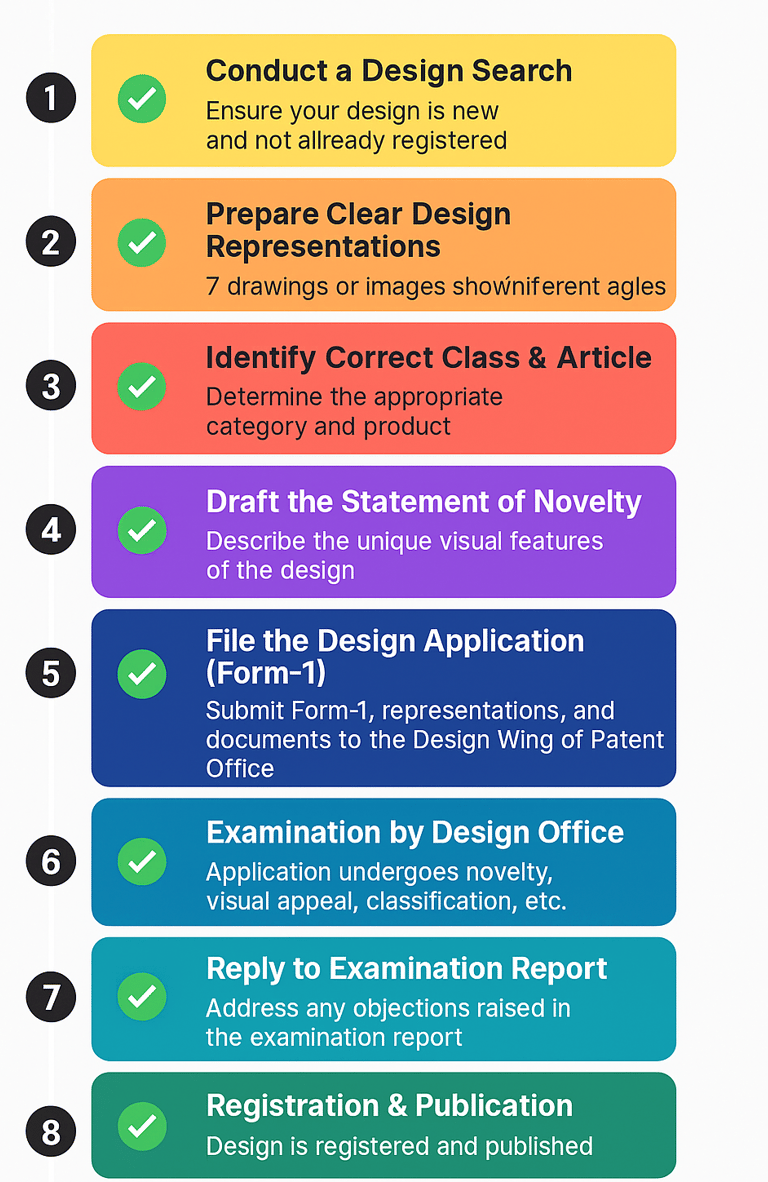

In accordance with the Designs Act, 2000, design registration in India entails a systematic legal and procedural process. Here's the way to do it right:
✅ Step 1: Conduct a Design Search (Optional but Recommended)
Prior to filing, do a design search on the Indian IP Portal to confirm that your design is new and not already registered. Why it matters: Prevents objections and rejection on account of duplication.
✅ Step 2: Prepare Clear Design Representations
Prepare 7 good quality drawings, images, or renderings of the product from different views — front, back, top, bottom, left, right, and perspective view. Requirement: A4 size, clean white background, no branding.
✅ Step 3: Identify Correct Class & Article
Apply the Locarno Classification System to class your product in the right class and article name.
Note: There are 32 main classes and more than 200+ subclasses.
✅ Step 4: Draft the Statement of Novelty
Prepare a short statement (max. 100 words) explaining the novel visual characteristics of the design.
Tip: Only describe external appearance, not function.
✅ Step 5: File the Design Application (Form-1)
File Form-1 accompanied by the design representations and supportive documents to the Design Wing, Patent Office (Kolkata/Delhi/Mumbai/Chennai) or online through [IPIndia Portal](https://ipindia.gov.in).
Documents required: * Statement of novelty * Power of Attorney (if necessary) * Priority documents (if necessary) * Fee receipt
✅ Step 6: Examination by Design Office
The application is subjected to formal examination to verify:
* Novelty * Looks * Proper classification * Compliance with the Designs Act Outcome: * If everything is fine → proceeds to registration * If objections are raised → response must be filed within time
✅ Step 7: Reply to Examination Report (if necessary)
If objections are raised, the applicant must submit a written response to the issues (e.g., similarity, classification, clarity). Handled by: The applicant or authorized agent.
✅ Step 8: Registration & Publication
If approved, the design is: * Registered in the Design Register * Published in the official Design Journal Effect: You acquire exclusive rights from the filing date, not the date of registration.
✅ Step 9: Receive the Design Registration Certificate
The certificate is issued online (or on paper upon request) and contains the registration number, filing date, class, and article.
✅ Step 10: Maintain & Renew (After 10 Years)
Design protection is effective for *10 years** Renewable once for *5 additional years** ⏳ Renewal has to be submitted before expiration in order to maintain exclusive rights
🤝 Why Choose Corporate Verdict for Your Design Registration?
Here's a convincing and professional section you may use on your website for:
Here at Corporate Verdict, we don't simply register your design — we safeguard your creativity and originality with accuracy and strategic foresight. Here's why hundreds of creators and companies rely on us for their Design Registration requirements:
✅ 1. Expert Legal Advisory
Our IP experts know design laws in and out. We make sure your design is registrable, compliant, and properly documented to avoid rejection or conflicts.
✅ 2. End-to-End Filing Support
From design preparation to filing, we take care of the complete registration process of designs, including representation before the Controller of Designs if required.
✅ 3. Error-Free Documentation
We provide absolute accuracy in documentation — an important step which is commonly rejected if done incorrectly. We cross-check each point before submission.
✅ 4. Quick Turnaround Time
Our efficient systems and professional staff see your design get submitted promptly and accurately, avoiding delays and enhancing probabilities for early approval.
✅ 5. Transparent & Affordable Pricing
No surprises. No hidden charges. Flat-rate, economical packages with transparency in each process step.
✅ 6. Design Protection Strategy
We not only counsel you on registration but also on how to maintain your design protected by the law in the future — including renewals, enforcement, and international filings.
✅ 7. Routine Status Monitoring & Updates
We keep you updated on all developments — application number to publication and acceptance — with routine updates and follow-ups.
✅ 8. Beloved by Startups & Brands Both
We've assisted startups, fashion designers, product innovators, and large companies safeguard what visually makes them distinct. Your design is in good hands with us.
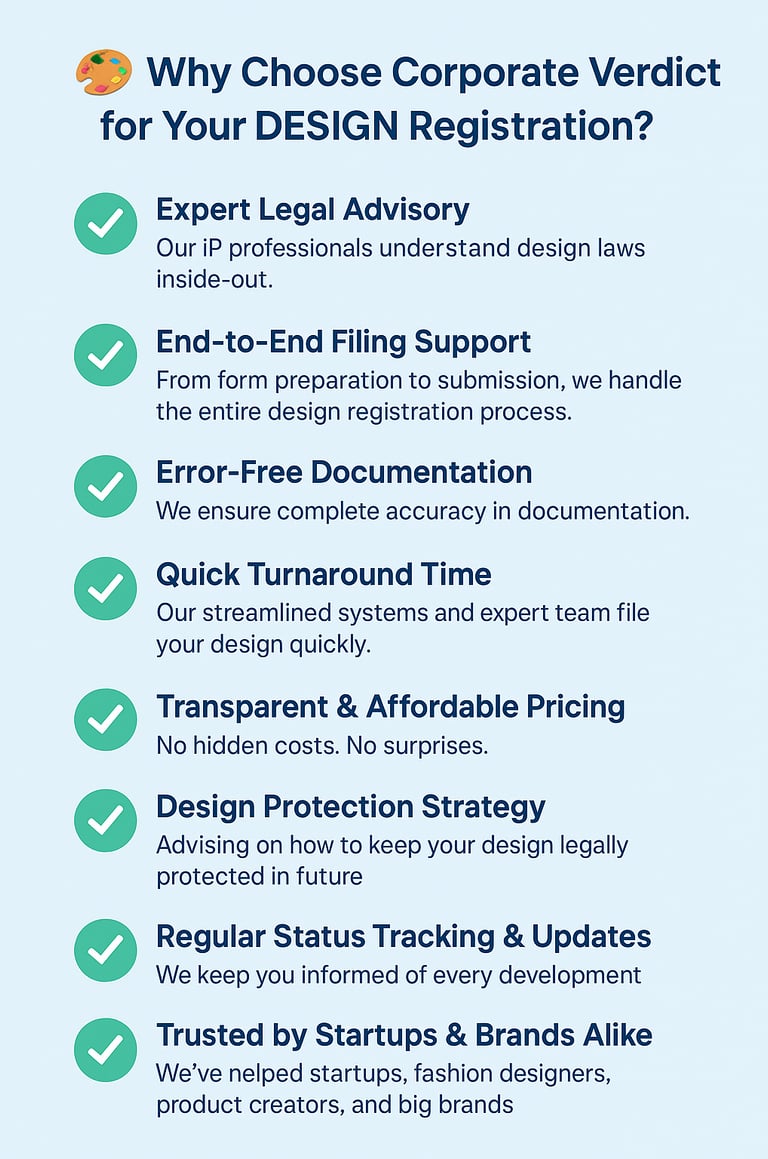

Contact us Now !
Get in touch
Have questions or need help with business registration, legal compliance, or corporate services?
Feel free to reach out to us:
📞 Call or WhatsApp: +91-7303632352
📧 Email: info@corporateverdict
